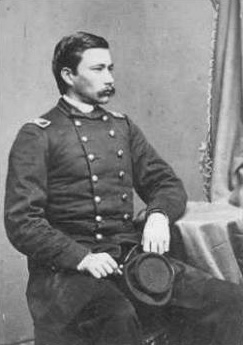George Dashiell Bayard facts for kids
Quick facts for kids
George Dashiell Bayard
|
|
|---|---|

George Dashiell Bayard
|
|
| Born | December 18, 1835 Seneca Falls, New York |
| Died | December 14, 1862 (aged 26) Fredericksburg, Virginia |
| Place of burial |
Princeton Cemetery, Princeton, New Jersey
|
| Allegiance | United States of America Union |
| Service/ |
United States Army Union Army |
| Years of service | 1856–1862 |
| Rank | |
| Commands held | 1st Pennsylvania Cavalry |
| Battles/wars | American Civil War |
George Dashiell Bayard (born December 18, 1835 – died December 14, 1862) was an important soldier in the United States Army. He became a general in the Union Army during the American Civil War. He was sadly wounded in a big battle called the Battle of Fredericksburg and passed away the very next day.
Contents
Early Life and Military Training
George Dashiell Bayard was born in Seneca Falls, New York on December 18, 1835. His parents were Jane Ann Dashiell and Samuel John Bayard. His family later moved to the Iowa Territory.
George went to the United States Military Academy at West Point. This is a famous school for training army officers. He graduated in 1856. He was 11th in his class of 49 students. After graduating, he became a second lieutenant in the U.S. cavalry. Cavalry soldiers ride horses into battle.
From 1856 to 1861, Bayard fought in the Indian Wars. These conflicts took place in Kansas and Colorado. On July 11, 1860, he was shot in the face with an arrow. He felt a lot of pain for many months after this injury.
Serving in the Civil War
The American Civil War began in 1861. On August 27, 1861, George Bayard was promoted to colonel. He joined the 1st Pennsylvania Cavalry. This unit was based in Tenallytown, which is now Tenleytown, Washington, D.C..
In November 1861, Colonel Bayard and his cavalry rode into Dranesville, Virginia. They were looking for Confederate soldiers. They found only two enemy pickets, who were like guards. Bayard also arrested six local citizens. He called them "secessionists of the bitterest stamp" in his report. These were people who strongly supported the Southern states leaving the Union.
As Bayard's soldiers and prisoners left Dranesville, they were shot at from the woods. Two Union soldiers were hurt. Bayard's horse was killed, and he was slightly wounded in his shoulder and thigh.
Promotions and Key Battles
On April 28, 1862, Bayard was promoted again. He became the Chief of Cavalry for the III Corps. He also became a brigadier general of U.S. Volunteers. This meant he was now a general.
General Bayard fought in several important battles. He served under General John C. Frémont at the Battle of Port Republic. In August 1862, he led an advance for the Union Army at the Battle of Cedar Mountain.
After the Battle of Cedar Mountain, General Bayard met with Confederate General J.E.B. Stuart. They met under a flag of truce. This was a special agreement to stop fighting temporarily. They arranged to collect the dead soldiers from the battlefield. Bayard and Stuart had been friends before the war. They had served together in the same cavalry unit. Stuart had also been two years ahead of Bayard at West Point.
Bayard was later promoted to Chief of Cavalry for the Left Grand Division of the Army of the Potomac. His old arrow wound still bothered him. He took a short break from the army in September. Because of this, he missed the Battle of Antietam.
Death at Fredericksburg
On December 13, 1862, a major battle took place at Fredericksburg. General Bayard was waiting for orders at the Bernard house. This house was the headquarters for Union General William B. Franklin. A Confederate artillery battery, which is a group of cannons, started firing at the headquarters.
General Bayard chose not to take cover. An artillery shell bounced through the front yard. It hit Bayard in his upper leg. The shell caused severe damage to an important blood vessel. Bayard was taken inside the Bernard house. He stayed there, badly wounded, until the next day. He died on the afternoon of December 14, 1862. He was just four days short of his 27th birthday.
George Bayard was engaged to be married. His fiancée was Miss Mary Eleanor Bowman. She was the daughter of the superintendent of the United States Military Academy. They had planned to get married on his birthday.
He was buried in Princeton Cemetery in Princeton, New Jersey. On his gravestone, you can see his family's motto. It says Sans peur et sans reproche. This means "Without fear or reproach" in French.
Legacy
Many places were named in honor of George Dashiell Bayard. Fort Bayard in Washington, D.C. was named after him. Bayard Street in Pacific Beach, San Diego, California, and in his hometown of Seneca Falls, New York, also carry his name.
Fort Bayard Park, which replaced the old fort, is also named in his memory. The town of Bayard, New Mexico, Fort Bayard, New Mexico, and Fort Bayard National Cemetery are also named after him. The cemetery is now part of the Fort Bayard Historic District. This district remembers the Buffalo Soldiers, who were African American soldiers.

